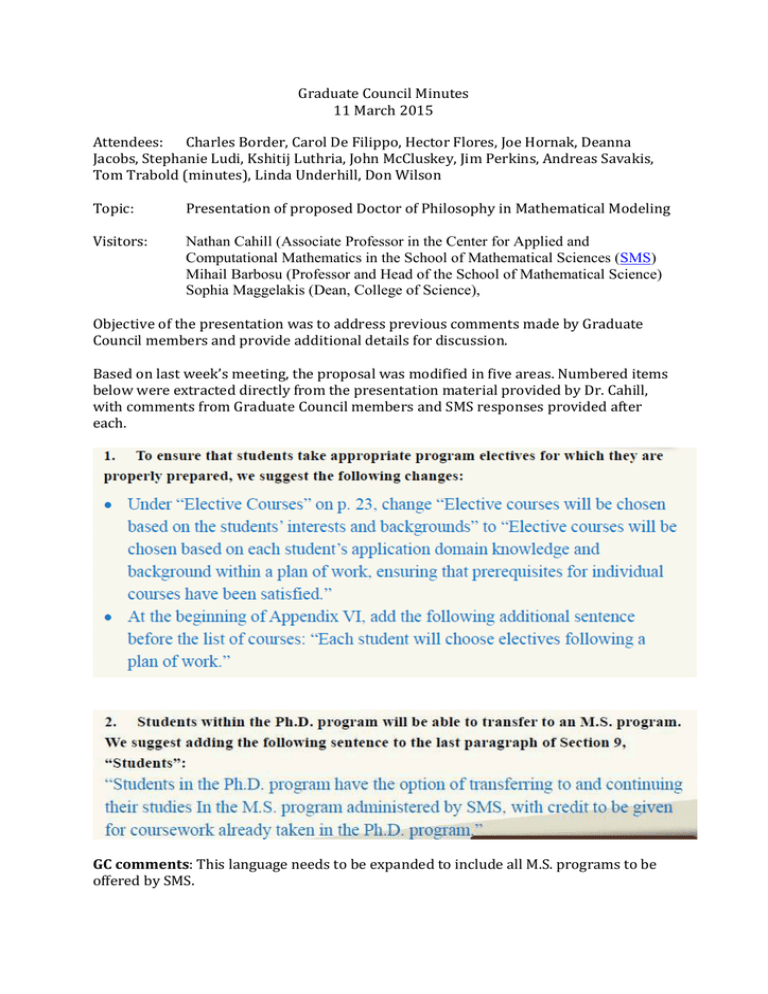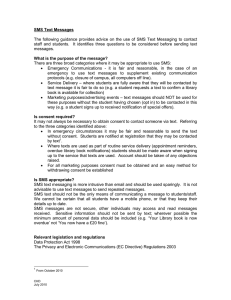Graduate Council Minutes 11 March 2015
advertisement

Graduate Council Minutes 11 March 2015 Attendees: Charles Border, Carol De Filippo, Hector Flores, Joe Hornak, Deanna Jacobs, Stephanie Ludi, Kshitij Luthria, John McCluskey, Jim Perkins, Andreas Savakis, Tom Trabold (minutes), Linda Underhill, Don Wilson Topic: Presentation of proposed Doctor of Philosophy in Mathematical Modeling Visitors: Nathan Cahill (Associate Professor in the Center for Applied and Computational Mathematics in the School of Mathematical Sciences (SMS) Mihail Barbosu (Professor and Head of the School of Mathematical Science) Sophia Maggelakis (Dean, College of Science), Objective of the presentation was to address previous comments made by Graduate Council members and provide additional details for discussion. Based on last week’s meeting, the proposal was modified in five areas. Numbered items below were extracted directly from the presentation material provided by Dr. Cahill, with comments from Graduate Council members and SMS responses provided after each. GC comments: This language needs to be expanded to include all M.S. programs to be offered by SMS. GC comments: Imaging Science requires 1st-year students receiving stipend to be TAs, and Astrophysics also has an informal TA model. The difference is that these programs have no formal training program. The proposed Math Modeling Ph.D. program would be a model for formal TA training. GC comment: To be consistent with the RIT Strategic Plan, SMS should consider the possibility of a major-minor format. SMS response: SMS would need guidance on how to implement such a plan, especially since the major-minor format has not yet been approved for Ph.D. programs. GC comment: Still not clear that a 5-year Ph.D. program in a specific research domain is needed to get a job and apply knowledge in the work force. SMS response: Academic positions obviously require a Ph.D. Even for those going into industry, interdisciplinary research work trains graduates to perform better in different application domains. The Ph.D. also enables graduates to lead projects and perform at a level beyond what would be expected for entry-level employees. GC comment: A better case for the value of a Ph.D. in this field can be made by including information from the book “The Mathematical Sciences in 2025” circulated during the meeting. GC comment: Has SMS considered the possibility of overlap/competition with other Ph.D. programs (Astrophysics, etc.)? Has there been communication with other Ph.D. Directors to confirm that they’re comfortable with this plan? There needs to be strong interaction between the SMS and faculty in application domains to ensure students receive the guidance they need. SMS response: Letters of support have been received from some departments (e.g., Physics). Other departments have provided verbal support, and don’t expect any significant impact on their courses with the numbers intended in the Math Modeling Ph.D. program. Each student will have an advisor upon entry into the program to guide them in what courses to take. The student’s committee will include a faculty member from their intended application area. SMS will ensure that admitted students have enough mathematical maturity and breadth of experience in the core subject areas. If experience is lacking, bridge courses may be needed. GC comment: Describe the financial model for the proposed Ph.D. program. SMS response: Service courses are an important part of the model, which seeks to cover the program’s costs while providing teaching experience for the students. Based on these objectives, 3 cases were considered: Case A: Ph.D. students replace Adjuncts o Financially negative, but the best option for pedagogical experience. Case B: Ph.D. students serve as Visiting Lecturers o Students conduct workshops, while the faculty maintains TAs. Case C: Ph.D. students conduct recitations o Best financial outcome, but not the best pedagogically. Details of the financial model were provided by Prof. Barbosu. GC comment: What is the role of external funding in this financial model? SMS response: Not needed for Case B or C, but would definitely be required to grow the research programs. The three sources of funding will be external grants, 1styear stipends (from the Institute), and TAs. GC comment: Will the TAs lengthen students’ time in the Ph.D. program? SMS response: The planned 6 contact hours will not be too much of a burden for students to finish in a reasonable time. Respectfully submitted by Tom Trabold




